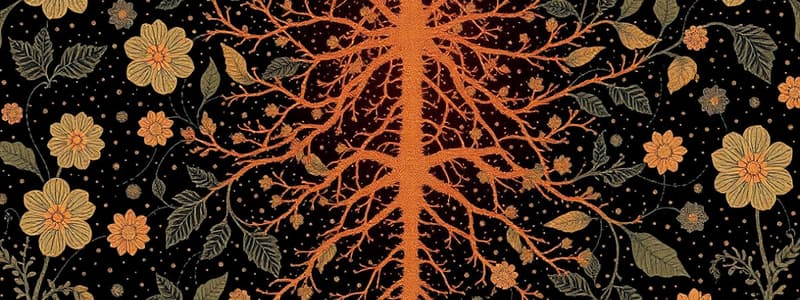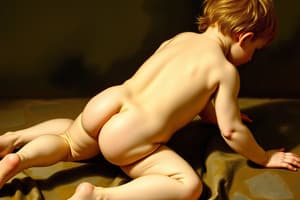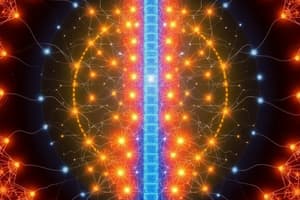Podcast
Questions and Answers
During a withdrawal reflex in response to touching a hot stove, which of the following neural processes contributes most directly to the rapid removal of your hand?
During a withdrawal reflex in response to touching a hot stove, which of the following neural processes contributes most directly to the rapid removal of your hand?
- Activation of the Golgi tendon reflex to inhibit muscle contraction.
- The crossed extension reflex causing rapid hand movement.
- Myotatic reflex causing immediate muscle contraction.
- Nociceptive signals triggering flexor muscle activation and extensor muscle inhibition. (correct)
If a person experiences damage to the medullary pyramids, which function is most likely to be impaired?
If a person experiences damage to the medullary pyramids, which function is most likely to be impaired?
- Control of heart rate and respiration.
- Regulation of sleep-wake cycles.
- Processing of auditory information.
- Voluntary motor control. (correct)
Which of the following accurately describes the role of reciprocal inhibition in spinal reflexes?
Which of the following accurately describes the role of reciprocal inhibition in spinal reflexes?
- It ensures that agonist and antagonist muscles are synergistically activated.
- It inhibits the activity of muscles opposing the intended movement. (correct)
- It involves the simultaneous contraction of muscles on opposite sides of the body.
- It prevents overstimulation of sensory neurons during reflex actions.
Following a stroke affecting the midbrain tegmentum, a patient exhibits difficulty integrating sensory information with motor commands. Which structure is most likely affected?
Following a stroke affecting the midbrain tegmentum, a patient exhibits difficulty integrating sensory information with motor commands. Which structure is most likely affected?
In the context of spinal reflexes, what is the primary purpose of autogenic inhibition?
In the context of spinal reflexes, what is the primary purpose of autogenic inhibition?
Which of the following structures is located within the spinal canal?
Which of the following structures is located within the spinal canal?
A patient presents with unilateral lower back pain, paresthesia, and numbness in the left lower leg, along with a diminished Achilles tendon reflex. Imaging reveals a herniation affecting the nerve root as it exits the vertebral column. Which of the following is the MOST likely location of disc herniation based on these symptoms?
A patient presents with unilateral lower back pain, paresthesia, and numbness in the left lower leg, along with a diminished Achilles tendon reflex. Imaging reveals a herniation affecting the nerve root as it exits the vertebral column. Which of the following is the MOST likely location of disc herniation based on these symptoms?
The anterior basal plate in the developing spinal cord primarily contributes to the formation of which structure?
The anterior basal plate in the developing spinal cord primarily contributes to the formation of which structure?
Which of the following best describes the anatomical relationship between spinal cord segments and vertebral levels in the adult human spinal column?
Which of the following best describes the anatomical relationship between spinal cord segments and vertebral levels in the adult human spinal column?
If a lesion specifically affected the gracile fasciculus at the T6 level of the spinal cord, which of the following sensory deficits would be expected?
If a lesion specifically affected the gracile fasciculus at the T6 level of the spinal cord, which of the following sensory deficits would be expected?
Which of the following arteries provides the PRIMARY blood supply to the anterior two-thirds of the spinal cord?
Which of the following arteries provides the PRIMARY blood supply to the anterior two-thirds of the spinal cord?
Following a spinal cord injury, a patient exhibits loss of voluntary motor control, but retains the ability to feel light touch and pressure. The MOST likely location of the lesion is in which area of the spinal cord?
Following a spinal cord injury, a patient exhibits loss of voluntary motor control, but retains the ability to feel light touch and pressure. The MOST likely location of the lesion is in which area of the spinal cord?
Which of Reed's laminae is responsible for receiving direct input from primary afferent fibers related to pain and temperature sensation?
Which of Reed's laminae is responsible for receiving direct input from primary afferent fibers related to pain and temperature sensation?
A patient has damage to the anterior corticospinal tract. What is the MOST likely result?
A patient has damage to the anterior corticospinal tract. What is the MOST likely result?
Which best describes the function of the 'filum terminale'?
Which best describes the function of the 'filum terminale'?
In a crossed extension reflex, what is the PRIMARY purpose of reciprocal inhibition?
In a crossed extension reflex, what is the PRIMARY purpose of reciprocal inhibition?
What is the main function of the great radicular artery of Adamkiewicz?
What is the main function of the great radicular artery of Adamkiewicz?
Which of the following accurately describes the location and function of the 'cauda equina'?
Which of the following accurately describes the location and function of the 'cauda equina'?
Which of the following is a key characteristic of the 'nucleus pulposus' in intervertebral discs?
Which of the following is a key characteristic of the 'nucleus pulposus' in intervertebral discs?
What is the function of the denticulate ligaments?
What is the function of the denticulate ligaments?
Flashcards
Myotatic Reflex
Myotatic Reflex
A spinal reflex that causes a muscle to contract in response to being stretched. Think knee-jerk.
Reciprocal Inhibition
Reciprocal Inhibition
Inhibition of antagonist muscles during agonist muscle contraction.
Autogenic Inhibition
Autogenic Inhibition
Relaxation of a muscle in response to high tension detected by Golgi tendon organs.
Crossed Extension Reflex
Crossed Extension Reflex
Signup and view all the flashcards
Superior Colliculus
Superior Colliculus
Signup and view all the flashcards
Primary Neurulation
Primary Neurulation
Signup and view all the flashcards
Secondary Neurulation
Secondary Neurulation
Signup and view all the flashcards
Conus Medullaris
Conus Medullaris
Signup and view all the flashcards
Cauda Equina
Cauda Equina
Signup and view all the flashcards
Spinal Cord Segment
Spinal Cord Segment
Signup and view all the flashcards
Cervical Radiculopathy
Cervical Radiculopathy
Signup and view all the flashcards
Lumbosacral Radiculopathy
Lumbosacral Radiculopathy
Signup and view all the flashcards
Annulus Fibrosus
Annulus Fibrosus
Signup and view all the flashcards
Nucleus Pulposus
Nucleus Pulposus
Signup and view all the flashcards
White Matter Columns
White Matter Columns
Signup and view all the flashcards
Gray Matter
Gray Matter
Signup and view all the flashcards
Dorsal Columns
Dorsal Columns
Signup and view all the flashcards
Spinothalamic Tracts
Spinothalamic Tracts
Signup and view all the flashcards
Corticospinal Tract
Corticospinal Tract
Signup and view all the flashcards
Study Notes
- The lecture discusses the spinal cord and brainstem, covering gross anatomy, vasculature, spinal cord segments/divisions, and regional brainstem anatomy
Spinal Cord
- Gross anatomy and vasculature including the spinal column and disc herniation
- Spinal cord and spinal segment divisions
- Fiber tracts
- Spinal reflexes
Spinal Cord Segments
- The segments are: cervical (C1-C8, enlarged), thoracic (T1-T12), lumbar (L1-L5, enlarged), sacral (S1-S5), and coccygeal (Co1)
Spinal Cord Segment Sections
- Consists of: dorsal sensory root, dorsal horn, intermediate gray matter, ventral motor horn, ventral root, as well as dorsal, lateral, and ventral columns
Spinal Cord Trail
- Spinal cord segments trail behind the vertebral column from T1 to Co1
- Meningeal dura, arachnoid, and denticulate ligaments span the subarachnoid space
Gross Anatomy
- Spinal Nerves in lumbar cistern, L2 to Co1, is the cauda equina
- Conus medullaris is the end of the spinal cord
- Pia mater extends as the filum terminale internum
- Meningeal dura extends as filum terminale externum
Vertebrae
- Articulating processes of vertebrae create nerve foramina
Spinal Canal
- It contains epidural fat, Batson's venous plexus, and the dural sac
Inter-vertebral Discs
- These contain a nucleus pulposus and annulus fibrosus
Ligaments
- The spinal cord has a: ligamentum flavum, interspinous ligament, and posterior longitudinal ligament
Radiculopathy - Cervical
- Occurs when the nerve root exits above the vertebrae, causing lateral herniation
Radiculopathy - Lumbo-sacral
- Occurs when the nerve root exits below vertebrae, leading to central, lateral, and posterolateral herniation
Cervical Disk Herniation
- It is a C5-C6 disk herniation
Cervical Disk Herniation Symptoms
- You may experience: unilateral neck pain, left arm pain, decreased arm strength, numbness in the thumb and index finger
Lumbo-sacral Disk Herniation
- It is a L5-S1 herniation
Lumbo-sacral Disk Herniation Symptoms
- You may experience: unilateral back pain, left lower leg paresthesias, left lower leg numbness, decreased sensation, and Achilles tendon reflex
White Matter Columns
- Organized into posterior, lateral, and anterior funiculus
Gray Matter - Reed's Laminae I-X
- Dorsal Horn deals with all sensory areas
- Ventral Horn deals with all motor areas
Spinal Cord Segment Divisions
- Fiber tracts are made up of white matter for sensory and motor info
- Dorsal columns gracile and cuneate fasiculi (= dorsal column medial lemniscus (DCML))
- Lissauer's (posterolateral) tract
- Anterolateral spinothalamic tracts (= anterolateral system (ALS))
- Spino-cerebellar tracts
- Lateral corticospinal tract LCS (motor)
- Anterior corticospinal tract ACS (motor)
- Rubrospinal tract (motor)
- Other motor sections include: recticulo-, vestibulo- & tecto-(spinal) tracts
- Neurons and nuclei are gray matter
- Dorsal horn houses substantia gelatinosa, and Reed's laminae
- Ventral (anterior) horn houses Reed's laminae
- Lateral (intermediate) horn houses Clarke's nucleus and Lissauer's laminae
Sensory Afferent Fibers
- Heavily myelinated proprioceptive fibers; lateral division of posterior root terminate in laminae III-V, VII, MNs (touch, proprioception)
- Less myelinated exteroceptive fibers; middle division of posterior root to other segments in Lissauer's tract, or terminate in laminae I-V (pain, temperature)
- Interoceptive fibers - medial division of posterior root; terminate laminae I, V-VII (visceral sensory from autonomic ganglia)
Sensory vs Visceral Associations
- GSA = somatic
- GVA = visceral
Motor Efferent Fibers
- Somatic efferents (heavily myelinated) supply skeletal muscles and spindles, located in MNs of laminae VIII, IX
- Visceral efferents supply visceromotor ganglia, located in MNs of intermediate zone, lamina VII
Somatic vs Visceral Associations
- GSE = somatic
- GVE = visceral
Spinal Cord Arterial Supply
- Vertebral artery branches are broken into anterior and posterior spinal arteries
- Arterial vasocorona is broken into central and sulcal arteries
- Made up of: segmental, medullary, and radicular arteries
- Great radicular artery of Adamkiewicz is found here
Spinal Venous Drainage
- Comprised of: anterior, posterior and lateral spinal veins, anterior and posterior radicular spinal veins, anterior and posterior internal and external plexus, and venous vasocorona
Regional Landmarks
- At the Medulla level are: Pyramids, Olives and Tubercles, and Trigones
- At the Midbrain level are: Colliculi as well as Mammillary Bodies
- The Pons level involves: Cerebellar Peduncles
- And cranial nerves are all throughout
Divisions of The Brainstem
- Brainstem contains a midbrain, pons, and medulla and has basilar regions
- The basilar region contains long fiber tracts and CNs
- The tegmentum contains reticular nuclei and fibers
- The midbrain tectum contains the corpora quadrigemina
Brainstem Parts and Associations
- Midbrain, pons, and medulla each has cranial nuclei and nerve components
- Midbrain tectum - corpora quadrigemina = superior and inferior colliculi
- Pontine, medullary and midbrain tegmentum – nuclei, reticular system, fiber tracts
- Basis - medullary pyramids (LCS decussation), brachium pontis, crus cerebri (cerebral peduncle)
Brainstem Landmarks
- Medulla / pons junction: cranial nerves VI, VII, VIII, brachium pontis / pyramids
- Pons / midbrain junction: cranial nerve IV, brachium pontis / cerebral peduncles
- Midbrain / thalamus junction: cranial nerve III, mammillary bodies (+ posterior commissure)
Studying That Suits You
Use AI to generate personalized quizzes and flashcards to suit your learning preferences.



